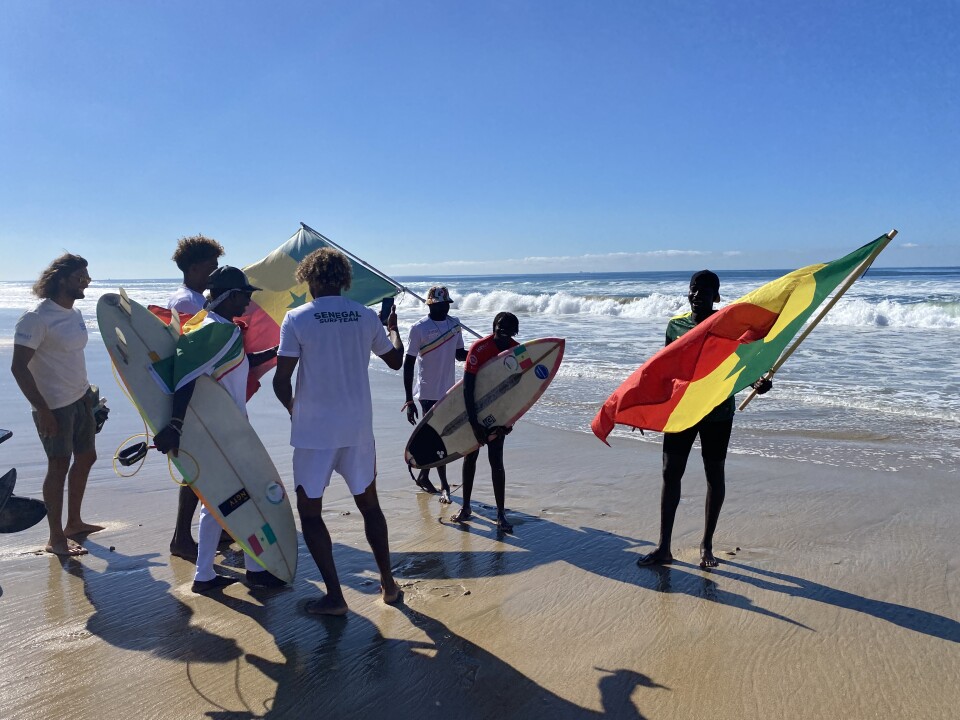With our free press under threat and federal funding for public media gone, your support matters more than ever. Help keep the LAist newsroom strong, become a monthly member or increase your support today.
The 2022 World Surfing Games Are Underway In Huntington Beach. Here’s How To Watch Like A Pro

Some of the planet's best surfers are shredding next to the Huntington Beach pier this week as the 2022 World Surfing Games advances toward the finals on Saturday. Nearly 250 athletes from 51 countries are vying for medals and an extra spot for their country at the Paris Olympics in 2024.
"It's one of the most important competitions we have," said USA Surfing head coach Ryan Simmons.
Despite the event's high-profile nature, it's about as spectator-friendly as one could ask for. No high-priced ticket or cable subscription needed. You can bring an umbrella and a beach chair and park yourself right in front of the action. Or watch the whole thing livestreamed for free on the event website.
Surfing debuted as an official sport at the 2020 Tokyo Olympic Games (the ones that actually took place in 2021). It's on the roster for the 2024 Paris games (no, surfing will not be on the Seine, it'll take place on the sick waves off the French Polynesian island of Tahiti). And it'll be a sport at the 2028 Los Angeles games (Huntington Beach is vying to be the host venue).
But how does competitive surfing even work?
I love watching good surfers catch waves that make my stomach drop and do tricks that would send me to the chiropractor. But I did not know how to watch, and understand, an actual surf competition. Until now.
Here's what I learned about how the World Surfing Games — and Olympic surfing, which goes by the same rules — works:
Who Competes In The World Surfing Games?
Even though surfing is an individual sport, men and women compete at the World Surfing Games as a team representing their country. They are vying for medals but also for a third spot for their country's team at the 2024 Paris games, beyond the two spots for men and two for women under Olympic rules.

There are also medals for the top four male and female surfers. The fourth-place winner gets a copper medal.
How Do The Surfers Compete?
The seven-day competition is broken down into heats, or mini-competitions, of four surfers each.
Heats usually last 20 minutes each, though semi-final and final heats often go longer. Competition organizers decide each morning how long the heats will last depending on ocean conditions (because sometimes there are lots of waves and sometimes there are almost no waves).
Within the heats, surfers rotate who has priority over an incoming wave, a relatively new rule designed to "avoid hustling or friction in the water," said Aguerre.
The top two surfers in each heat advance to the next rung in the heat bracket.
The losers get a second chance (actually two), called "repechage" (pronounced re-pe-SHAZH). If a surfer keeps winning their repechage heats, they'll eventually advance to the finals and can even win the gold. "That happens more often than you think," said Fernando Aguerre, president of the International Surfing Association (ISA), the governing body of surf competitions recognized by the International Olympic Committee.
In other words, if you're going to watch a surf competition, don't discount the repechage heats.
Athletes in the repechage round do have to surf more heats than competitors in the winners' round, Aguerre said, sometimes two per day. So stamina helps.
Surfers have to lose twice to be knocked out of the competition completely.

How Do Surfers Win Their Heat?
A panel of five judges evaluates a surfer's ride, per the ISA rulebook, on:
- Commitment and Degree of Difficulty
- Innovative and Progressive Maneuvers
- Combination of Major Maneuvers
- Variety of Maneuvers
Aguerra put it like this: "The judges evaluate your ability to ride the wave in the most difficult areas of the wave, in the most powerful maneuvers, always in control, and with speed and with fluidity. That means we want to see you flowing in the wave with hard maneuvers, but always in control."
A surfer's top two wave scores make up their overall score for the heat.
What's a hard maneuver? Something like this:
Or this:
Oh, and you have to stick the landing or you get docked points.
Going Even Deeper On Scoring
Specific to the Huntington Beach venue, surfers almost get two rides on one wave. You'll see them pull some big moves when they first catch the wave, then the wave slows down and surfers usually have to "pump" their board (make little hops, pushing it forward with their body weight) to stay on the wave until it starts to get steep again near the shore.
"At Huntington, you have the shorebreak so you're weaving through and trying to end with, like, a big finish," explained USA coach Simmons. "I call it like the exclamation point on your wave. So that's kind of the dynamic of Huntington, a big maneuver out the back or two, reform the wave and try and finish. It's the last thing that judges see to sort of stamp your score."
Two more things about scoring, if you want to go deep:
- The highest and lowest of the five judges' scores are thrown out; the remaining three are averaged.
- Every surfer has a camera trained on them and judges can check out the replay if they need closer inspection to determine their score.
What's A Good Score And Who's Getting Them?
A perfect score for a wave is 10. A perfect score for the heat would be 20.
At the end of Day 4 of the World Surfing Games, USA.'s Griffin Colapinto had the top score for a heat, 17.00. Not far behind him were Japan's Kanoa Igarashi and Shino Matsuda, with top heat scores of 16.87 and 16.27, respectively, and Peru's Lucca Mesinas, with a top heat score of 16.07.
On the women's side, Australia's Sophie McCulloch held the top heat score, at 16.43, followed by USA's Kirra Pinkerton and Gabriela Bryan, with 16.00 and 15.93, respectively, and Australia's Sally Fitzgibbons with a top heat score of 15.50. (NOTE: What really matters is a surfer's combined score as the competition progresses, but this gives an idea of who to watch.)
Which Countries Are Producing The Top Surfers?
Until recently, a few big surfing countries, including Australia, USA and Brazil, largely dominated competitive surfing. But that's changing, said USA surf coach Simmons. "The big teams in this [competition] would be like Australia, Brazil, Portugal, Spain, France, Costa Rica. … The level in the last four years has risen due to all of the other countries seeing what the top countries are doing. And there's about 12 teams that could potentially win the gold, so it's tough," he said.
Last year, France won the team gold. In 2019, it was Brazil. The finals take place on Saturday, Sept. 24.








